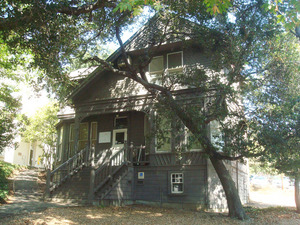Q. There used to be two cute little Victorian houses on the Boalt Hall parking lot. When I was over there the other day, they were both gone. What happened to them? – WCJ, Oakland

A. The two houses at 2241 and 2243 were among the last reminders that College Avenue (once known as Audubon Street) used to extend beyond Bancroft Way, winding among the trees that graced the southeast corner of the campus.
In 1885 Warren and May Cheney built a home at 2241 College Avenue in the fashionable Berkeley Property Tract laid out by Frederick Law Olmstead, the designer of New York’s Central Park. “The lot was apparently well landscaped,” notes the Historical Structures Report prepared by the Department of Capital Projects, “an account from the early 1900s briefly mentions an ornamental fish pond on the property, and Warren Cheney, the grandson of the original owner, recalled that his grandfather used to grow roses in front of the house, as did their neighbor to the north, Professor [Frederick] Slate.”
The Cheneys were both Cal graduates, Warren in 1878 and May in 1883. Though Warren Cheney earned a law degree from Hastings, he apparently never practiced, instead starting his own real estate and insurance businesses. His passion was writing, and his short stories were published in the West’s two most prestigious periodicals: Sunset Magazine and the Overland Monthly. He also authored three novels, including The Challenge (1906) illustrated by N.C. Wyeth. The young couple hosted an informal bohemian salon at their home that attracted local artists and writers. Frank Lloyd Wright admired the view from their front porch. Jack London once lounged under the trees that now shade the Boalt Hall parking lot.
May Cheney was one of the earliest professional women working on the Berkeley campus. (Her son reported that “she had to work in order to provide income from her growing family while her husband pursued a writing career.”) Shortly after graduating from Cal she established the Pacific Coast Bureau of Education in San Francisco, a placement agency that found jobs for school teachers. She approached UC President Martin Kellogg about setting up a similar bureau on campus. He suggested that she first review the newly-established Harvard University Appointments Committee, the first university-affiliated placement service in the country. The following year President Kellogg appointed May Cheney to head a similar placement office at Berkeley — making Cal the second university in America to offer such a service. By 1919 her office was processing over 3000 applications a year for teaching positions. She ran the program for forty years.
The Cheneys raised four sons in the little house on College Avenue. Their second son, Sheldon, followed in his father’s artistic footsteps, “pursu[ing] a life at the cutting edge of modern culture, particularly in the visual and dramatic arts.” He was a friend of Isadora Duncan and Gordon Craig, and founded Theater Arts Magazine in 1916. His writings on the history of the theatre are said to have had a profound influence on Eugene O’Neill.
In 1902 Warren and May Cheney built a second house on their lot, this one to use for rental income. In 1939 both houses were purchased by the University, and over the years the buildings were used for a number of purposes, most recently for Women’s Studies and the Tanner Lectures program. The houses were scheduled for removal as part of the Law-Business Connection construction, but they received a reprieve when that project was postponed. Unfortunately, the space occupied by the now-vacant houses was needed by Hunt Construction for offices as they proceed with the remodeling of Memorial Stadium. This spring the Cheney home was demolished, and the rental house was sold to a private buyer, who had it moved to another location. Temporary construction trailers now occupy the lot — along with the ghosts of Jack London and Frank Lloyd Wright.
CORRECTION: Last month’s column, suggesting that separate Boalt Hall graduations began in 1970, was based on an ambiguously worded article in The Transcript announcing the inauguration of a “more formal” graduation. As several readers have pointed out, Boalt Hall’s graduation has been separate at least since the 1950s. Archivists should remember that people make better sources than publications!
Have a question? Ask the Archivist: benemann@law.berkeley.edu